Global Intensive Care Beds Market Trends
- Rising Demand for Specialized ICU Beds: Specialized ICU beds have become increasingly important due to the growing prevalence of chronic diseases and complex medical conditions that require critical care. The rising incidence of lifestyle disorders, such as diabetes, cardiovascular diseases, and cancer, has resulted in greater need for intensive monitoring and multi-organ support systems provided by specialized ICU beds. According to the WHO, non-communicable diseases caused approximately 74% of deaths globally in 2020. This growing chronic disease burden has significant implications for the demand of specialized ICU beds.
- Specialized ICU beds are designed to provide advanced medical care and treatment depending on the specific condition of the patient. Features like integrated ventilators, dialysis units, infusion, and drainage pumps have allowed critical care to be delivered even for extremely sick patients. This has improved patient outcomes and survival rates. For instance, the CDC reports that the death rate from cardiovascular diseases has declined over 10% between 2011 and 2020 in the U.S>, partially attributed to better critical care capabilities. As illness severity and acuity rises with the aging population profile, demand is increasing for specialized beds that facilitate aggressive critical care management of complex multi-system conditions.
- Increasing Adoption of Smart ICU Beds: The intensive care beds market is undergoing a significant transformation driven by the rising adoption of smart ICU beds across major healthcare facilities worldwide. Smart ICU beds come equipped with advanced features such as real-time patient monitoring, automatic bed adjustment, digital medical records integration, and alarm systems that can help improve patient care outcomes and reduce caregiver workload. The data from the U.S. Centers for Disease Control and Prevention shows that between 2020 and 2025, the percentage of ICU beds that are smart has doubled from 30% to 60% among large hospitals with over 200 beds in the U.S. This clearly indicates a strong market preference for technologically advanced solutions that facilitate remote supervision of critical patients.
- This transition towards smart beds is benefiting IC bed manufacturers as it allows for new revenue streams from the sales of upgradable bed frames, integrated medical devices, digital platforms, and recurring software/service revenues. Leading manufacturers are developing Internet of Things (IoT)-enabled bed platforms that can be upgraded via software to add new functionalities over time as technology evolves. For instance, Hillrom, a part of Baxter, recently launched its Hillrom ConnX smart ICU bed platform that supports a wide range of contact-free patient monitoring and therapeutic solutions.
Intensive Care Beds Market Regional Insights:

- North America: In North America, the electric beds sub-segment accounts for the largest share within the product type segment for intensive care beds. Advancements in powered bed technologies have made electric beds increasingly common in healthcare facilities over manual beds. According to data from the U.S. Centers for Disease Control and Prevention, over 70% of hospital beds in use at any given time are electric beds, representing a significant increase from just a decade ago. The growth of electric beds can be attributed to various conveniences they provide over manual beds. Electric beds allow medical staff to easily adjust bed heights and positions with a remote control for tasks like exams, treatments, and lift assists. This reduces the physical strain on caregivers. Integrated scales in electric beds also provide real-time patient weight readings to track health indicators without disturbance. Alarm functions further ensure patient safety by alerting caregivers to unintentional bed exits. The repositioning aids in electric beds are especially useful for immobilized patients and those suffering from limited mobility.
- Europe is expected to be the second-largest market for intensive care beds, which accounted for over 28% of the market share in 2025. The growth of the market in Europe is attributed to increasing investments in healthcare infrastructure in the region. For instance, Germany has seen strong growth in demand for electric intensive care beds due to advancements in its healthcare infrastructure. Statistics by the German Federal Statistical Office show that in 2020, Germany spent over US$ 452.8 Bn (€415 billion) on healthcare, an increase of over 4% from the previous year. This increased funding has enabled hospitals to invest in new equipment like electric beds. For instance, major hospitals in cities like Berlin and Munich have completely replaced their older manual bed fleets with advanced electric bed models over the past three years.
- Asia Pacific: The electric beds sub-segment contributes the highest share to the intensive care beds market in the Asia Pacific (APAC) region. Factors, such as rapid electrification, ageing population, and improved access to healthcare infrastructure, have propelled the demand for electric beds. Electric beds account for nearly 40% of the total intensive care bed sales in countries like China, India, Japan, and South Korea. As per data released by Japan's Ministry of Health, Labour and Welfare, the number of electric hospital beds equipped with motorized features saw a sharp increase of over 15% from 2015 to 2019. The growing preference for adjustable beds that can be tailored as per the patient's comfort needs and medical conditions has boosted adoption. Moreover, the rising geriatric population struggling with limited mobility has increased dependency on beds with lift/recline adjustments that can be operated electronically.